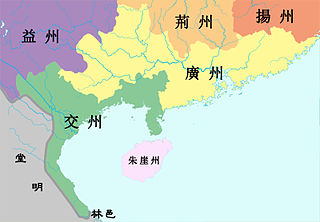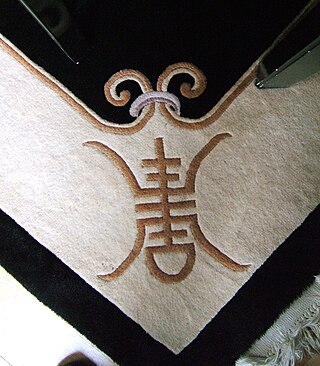
Prunus mume is a Chinese tree species classified in the Armeniaca section of the genus Prunus subgenus Prunus. Its common names include Chinese plum,Japanese plum, and Japanese apricot. The flower, long a beloved subject in the traditional painting and poetry of Sinospheric countries, is usually called plum blossom. This distinct tree species is related to both the plum and apricot trees. Although generally referred to as a plum in English, it is more closely related to the apricot. In East Asian cuisine, the fruit of the tree is used in juices, as a flavouring for alcohol, as a pickle, and in sauces. It is also used in traditional medicine.

Yu the Great or Yu the Engineer was a legendary king in ancient China who was credited with "the first successful state efforts at flood control", his establishment of the Xia dynasty, which inaugurated dynastic rule in China, and for his upright moral character. He figures prominently in the Chinese legend titled "Great Yu Controls the Waters". Yu and other sage-kings of ancient China were lauded for their virtues and morals by Confucius and other Chinese teachers. He is one of the few Chinese monarchs who is posthumously honored with the epithet "the Great".

The death poem is a genre of poetry that developed in the literary traditions of the Sinosphere—most prominently in Japan as well as certain periods of Chinese history, Joseon Korea, and Vietnam. They tend to offer a reflection on death—both in general and concerning the imminent death of the author—that is often coupled with a meaningful observation on life. The practice of writing a death poem has its origins in Zen Buddhism. It is a concept or worldview derived from the Buddhist teaching of the three marks of existence, specifically that the material world is transient and impermanent, that attachment to it causes suffering, and ultimately all reality is an emptiness or absence of self-nature. These poems became associated with the literate, spiritual, and ruling segments of society, as they were customarily composed by a poet, warrior, nobleman, or Buddhist monk.

Buddhism in Vietnam, as practiced by the Vietnamese people, is a form of East Asian Mahayana Buddhism. It is the main religion in Vietnam. Vietnamese Buddhism is generally inclusive and syncretic, drawing on the main Chinese Buddhist traditions, such as Tiantai and Huayan, Zen (Thiền), and Pure Land.
Vietnamese literature is the literature, both oral and written, created largely by the Vietnamese. Early Vietnamese literature has been greatly influenced by Chinese literature. As Literary Chinese was the formal written language for government documents, a majority of literary works were composed in Hán văn or as văn ngôn. From the 10th century, a minority of literary works were composed in chữ Nôm, the former writing system for the Vietnamese language. The Nôm script better represented Vietnamese literature as it led to the creation of different poetic forms like Lục bát and Song thất lục bát. It also allowed for Vietnamese reduplication to be used in Vietnamese poetry.

In art and iconography, a motif is an element of an image. Motifs can occur both in figurative and narrative art, and in ornament and geometrical art. A motif may be repeated in a pattern or design, often many times, or may just occur once in a work.

In Chinese mythology, Peaches of Immortality are consumed by the immortals due to their mystic virtue of conferring longevity on all who eat them. Peaches symbolizing immortality are a common symbol in Chinese art, appearing in depictions or descriptions in a number of fables, paintings, and other forms of art, often in association with thematically similar iconography, such as certain deities or immortals or other symbols of longevity, such as deer or cranes.

Kanō Sansetsu was a Japanese painter also known as Kanō Heishiro. He was born in Hizen Province, Kyūshū, and died in Kyoto.
In Chinese art, the Four Gentlemen or Four Noble Ones, is a collective term referring to four plants: the plum blossom, the orchid, the bamboo, and the chrysanthemum. The term compares the four plants to Confucian junzi, or "gentlemen". They are commonly depicted in bird-and-flower paintings, a broad category of classical Chinese art, and they are particularly popular subjects for ink wash painting.

The national flower of the Republic of China was officially designated as the plum blossom by the Executive Yuan of the Republic of China on 21 July 1964. The plum blossom, known as the meihua, is a symbol for resilience and perseverance in the face of adversity, because plum blossoms often bloom most vibrantly even amidst the harsh winter snow. As the plum tree can usually grow for a long time, ancient trees are found throughout China. Huangmei county in Hubei features a 1,600-year-old plum tree from the Jin Dynasty which is still flowering. The three stamens represents Dr. Sun Yat-sen's Three Principles of the People, while the five petals symbolize the five branches of the government: Executive Yuan, Legislative Yuan, Judicial Yuan, Examination Yuan and Control Yuan. The flower has also been proposed to be one of the national flowers for the People's Republic of China.

Works of bamboo painting, usually in ink, are a recognized genre of East Asian painting. In a work of bamboo painting in ink, a skilled artist and calligrapher will paint a bamboo stalk or group of stalks with leaves. The contrast between the foreground and background, and between the varying textures represented by the stalks and the leaves, gave scope to the painter to demonstrate his or her mastery with an inkpot and a brush.

Jiaozhou was an imperial Chinese province under the Han and Jin dynasties. Under the Han, the area included Liangguang and northern Vietnam but Guangdong was later separated to form the province of Guangzhou by Sun Quan following the death of Shi Xie and lasted until the creation of the Annan Protectorate in 679.

A meiping is a type of vase in Chinese ceramics. It is traditionally used to display branches of plum blossoms. The meiping was first made of stoneware during the Tang dynasty (618–907). It was originally used as a wine vessel, but since the Song dynasty (960–1279) it also became popular as a plum vase and got its name "meiping". It is tall, with a narrow base spreading gracefully into a wide body, followed by a sharply-rounded shoulder, a short and narrow neck, and a small opening.

Shòu is the Chinese word/character for "longevity".

Vase with carved peony scrolls is a Cizhou-type stoneware vase of the Northern Song dynasty, made about 1100 and now in the Asian collection of the Indianapolis Museum of Art, where it is currently on display in the Richard M. Fairbanks Gallery.
The Flowers of the Four Seasons are a traditional grouping of flowers found in Chinese culture that spread to and influenced other East Asian arts.

The depiction of night in paintings is common in art in Asia. Paintings that feature the night scene as the theme are mostly portraits and landscapes. Some artworks which involve religious or fantasy topics use the quality of dim night light to create mysterious atmospheres. They tend to illustrate the illuminating effect of the light reflection on the subjects under either moonlight or artificial light sources.

The Tomb of General Zu Dashou is one of the earliest pieces in the Royal Ontario Museum’s collections, and on the museum's list of Iconic Objects.
Trees in Chinese mythology and culture tend to range from more-or-less mythological such as the Fusang tree and the Peaches of Immortality cultivated by Xi Wangmu to mythological attributions to such well-known trees, such as the pine, the cypress, the plum and other types of prunus, the jujube, the cassia, and certain as yet unidentified trees. Mythological ideas about trees also extends to various types of fungi which lived or were thought to live underneath certain of these trees, collecting their mysterious essences.

Sacrifice to Heaven is an Asian religious practice originating in the worship of Shangdi in China. In Ancient Chinese society, nobles of all levels constructed altars for Heaven. At first, only nobles could worship Shangdi but later beliefs changed and everyone could worship Shangdi.


















